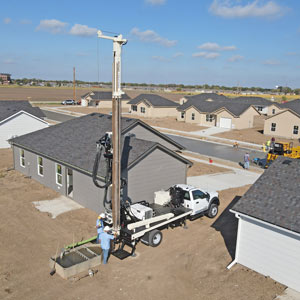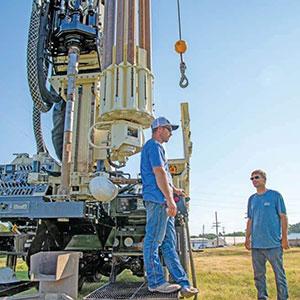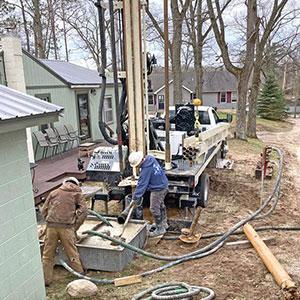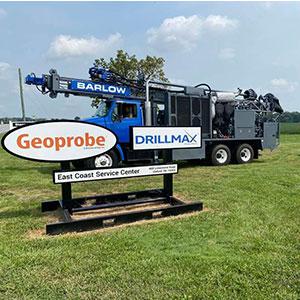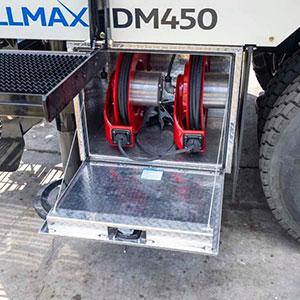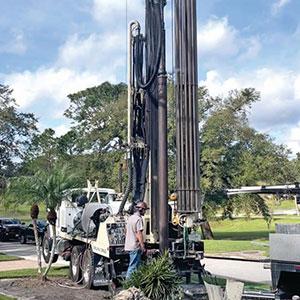

Products Specifically
Designed for Water Well
and Geothermal Contractors
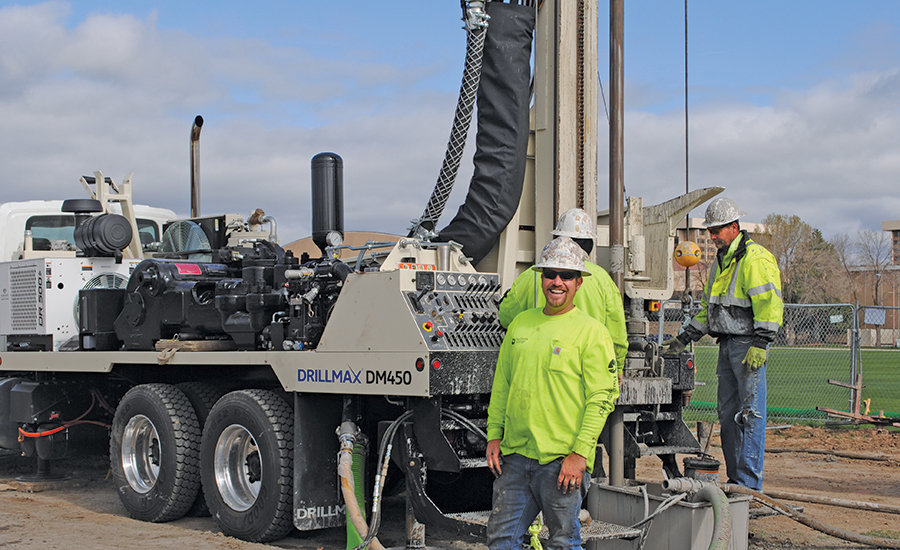
The speed and ability of the single rod loader to keep adding pipe make the DM450 well suited for geothermal energy jobs.
Businesses and homeowners are increasingly honing in on the benefits geothermal energy systems offer beyond being a green, reliable energy source. Often, savings on monthly utility bills pay for financing a system. Many see a return on their investment in a geothermal retrofit. In recent years, the federal government — and even some states — implemented tax credits and incentives for the renewable energy option.
Taking Geothermal Well Drilling Business to Next Level
Launching Island Geo Drillers in New York seven years ago, Joe Dalba and partner Ryan Maletta were ready to take their closed-loop geothermal installation business to the next level. Their projects were progressing from residences with up to 50-ton fields to schools requiring 300-ton fields with 90 bores to 350 feet. Yet, they desired to go after more municipal projects. What they needed to take the next step was a new drill rig.
“We wanted to increase efficiency,” Dalba said. “We wanted to go deeper and needed more power and pullback, switching from 10-foot to 20-foot stroke to clear holes of cuttings.”
They looked at several different rigs, wanting to keep everything non-CDL.
“To get a more capable rig and take our business to the next step, the DRILLMAX® DM250 [by Geoprobe®] was the only one non-CDL,” Dalba said. “Others with these capabilities required a CDL or were not yet in production, just prototypes.”
Dalba did his research, talking to other DRILLMAX® by Geoprobe® owners on the island.
”I watched videos and thought, ‘It can’t be that fast.’ It almost startles you,” Dalba said. “With our old rig, I’d look at the pressure gauge because I had time to, but this just happens in the blink of your eyes.”
On one job, COVID-19 restrictions limited them to just the two owners on site. Dalba and Maletta completed the 15 bores to 305 feet through tough, plastic clay in 80 percent of the hole. Dalba ran the rig. Maletta worked the mud cleaner, getting loops ready for installation.
“The DM250 took a beating but got right through it. We doubled our production speed with the stroke and pump,” Dalba said. “The way the rig forces plastic clay out of the hole was pretty unbelievable. The 20-foot stroke and speed of the tophead mean it goes faster for a longer distance, good for plunging clay out of the hole.”
The pressure consistency produced by the piston pump, physical comfort created by the wide driller’s platform, and production capability provided by the rod loader add to the advantages afforded by the DM250.
“It has everything really. It’s faster and lots easier,” Dalba said. “Speed of tophead rotation combined with 20-foot stroke on tight package, ramps up production, and it being non-CDL also saves on insurance.”
Going at ‘Geo-Pace’
Going after big mud rotary work, PanTerra Energy is often hired after someone has been unsuccessful. But their powerful equipment isn’t the only source of the Colorado-based company’s success.
“Our success is due to our equipment, diversification of services, and ability to train and produce quality people,” Skyler Wilson, operations manager, said.
PanTerra’s ability to easily — at interstate speeds — mobilize their fleet of smaller, lightweight rigs also contributes to increased demand for their services, which prompted purchase of a new DM450.
“Even with COVID-19, the majority of the drilling market has been really, really busy,” owner Mike Ryan said. “We’d have never survived if we just did geothermal once the tax credit went away. But in the last 14-15 months there’s been an uptick in the school and university market, and we continue to grow our other service lines.”
When comparing their 2020 DM450 to their 2015 model, improvements include rollers on the carriage and sleekly laid out hydraulic lines, while the manual hydraulic controls provide the power and precision Wilson has come to expect from DRILLMAX® by Geoprobe® rigs.
”The rigid drill mast design drills straighter holes,” Wilson said. “The redesigned rod spinner increases efficiency tripping out of the hole.”
SPEED FOR GEOTHERMAL ENERGY
The speed and ability of the single rod loader to keep adding pipe make the DM450 well suited for geothermal jobs.
“On average, the DM450 is 1.5 times faster than our other rig,” Wilson said. “Just the tophead movement on the other rig takes twice as much time as swinging the rod handler. Once you’re out of rod in the other rig carousel, adding pipe takes 10 times as long.”
The driller was impressed the DM450 kept up with the “geo-pace of drilling four to five holes a day.” He boasts the DM450 accomplished more than the combined footage of three other rigs on a geothermal job in the Rockies.
POWER FOR CATHODIC PROTECTION
Completing 8- to 12-inch diameter holes, 300 to 1,000-feet deep is standard for cathodic protection. PanTerra has done 10-inch to 320 feet, drilling the hole in one day and coming back to clear the hole the second — keeping production right on schedule. Wilson credits the 5.5 X 8 mud pump for their success.
“We have the pressure to lift heavy cuttings out of the hole. It’s close to putting out the volume of a 4 X 3, but with 200-250 psi pressure to clear the hole,” Wilson said. “We’re able to muscle in the hole to depth and clean up afterwards.”
The demand for cathodic protection services takes PanTerra to 15 different states in order to meet the needs of their customers.
“We’re not a big company, but have a significant footprint,” Ryan said. “We’re a people-first, equipment-second company.”
SERVICE SUPPORT
Having a central U.S. service center nearby provides peace of mind. A recent stop in Kansas added valuable training for their driller.
“The engineers exchanged knowledge with the driller as to why the rig was designed a certain way. The driller shared our field challenges,” Wilson said. “This will probably help someone down the road.”
The driller was impressed with the engineering team.
“There were a lot of smart ideas being discussed. The DRILLMAX® [by Geoprobe®] engineers offered solutions done right, not just Band-Aids,” he said.
For Ryan, having engineers receptive to driller feedback for product improvement distinguishes DRILLMAX® by Geoprobe® from other manufacturers.
“It’s not always the case that engineers have an open mind to suggestions from drillers,” he said. “DRILLMAX® [by Geoprobe®] engineers seem to really be interested in feedback from the field. When it comes down to it, it’s about people. The DRILLMAX® [by Geoprobe®] commitment to make things right is important.”
Contact Us
1835 Wall Street
Salina, KS 67401
Phone: (785) 825-1842
Fax: (352) 237-0450
Photo Gallery

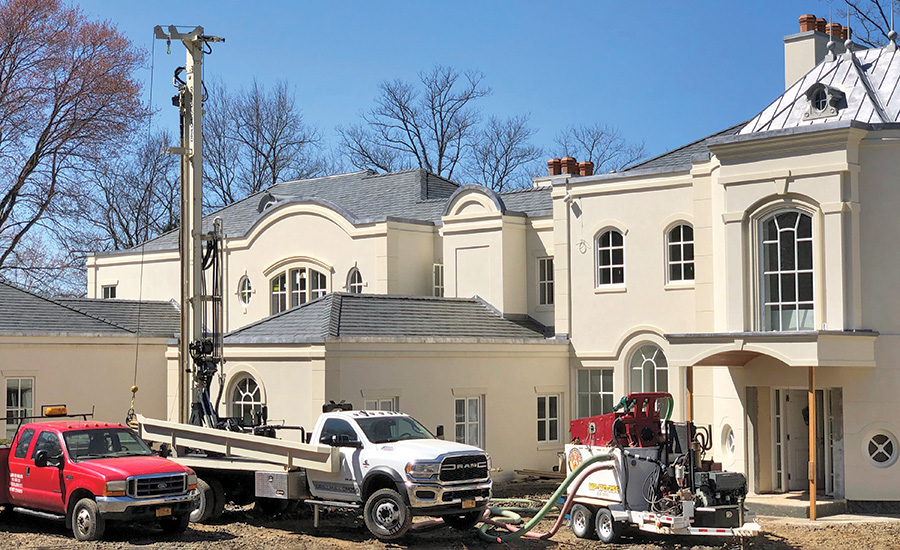
Related Articles
Whether a veteran driller or just starting out, a factory visit provides valuable insight when making the investment required to purchase a new rig. Taking time to see firsthand how the rig you’re considering is engineered and manufactured and meeting the
ID: 218 | Date:
Getting their start in 1992 doing mostly environmental work at gas stations, SHEPLER WELL DRILLING does 75 percent environmental and 25 percent residential work. Lately a lot of their work involves production wells and recovery wells in oil fields.
ID: 217 | Date:
Four decades ago Michael Barlow began installing pumps and drilling wells with one rig. He diversified into commercial geothermal projects in the early '90s. Today MICHAEL BARLOW DRILLING & SERVICE INC. completes as much service volume as drilling. This i
ID: 215 | Date:
SPEED PRODUCTION AND ELIMINATE BIGGER SUPPORT TRUCK WHEN CHOOSING ON-BOARD HYDRAULIC WELDER.
ID: 212 | Date:
Running one legacy model DM450, family-owned DICK JOYCE WELL DRILLING found themselves looking for a solution to their lengthening list of work.
ID: 211 | Date:
